Big Sur River Restoration
Familiarization Outing – Thursday, June 19, 2008

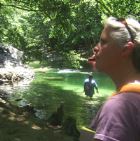
A citizens’ group is forming to help the Big Sur River which is in peril from too much human use. In these photographs, Jeff Fry, State Park Environmental Scientist, and Jack Ellwanger, PelicanNetwork founder, showed some of the river’s problems to a group of interested locals. Joining the walk were representatives of the California Dept. of Fish and Game, and the Big Sur Land Trust.
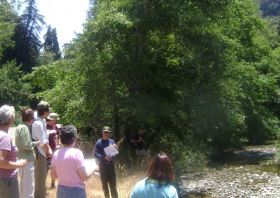

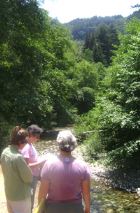
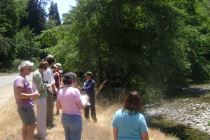
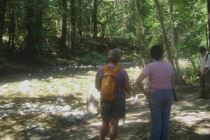

The group saw how overuse has harmed the native fish habitat. People trampling the riversides have denuded stream banks. Nesting areas are destroyed by horse trail crossings and people damming the stream and throwing rocks into the fragile spawning areas.
Jeff pointed out areas where sediment runoff from the highway is harming the river with petroleum-based contaminants. Some parts of the river need their banks shored and bolstered to stop accelerating erosion.
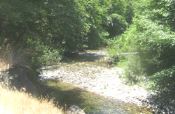
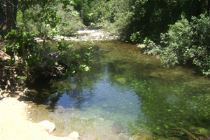
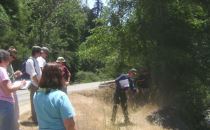

Proceeds from the 2008 Big Sur Chanterelle Cook Off provided
funds to create Stewards of the Big Sur River.
Big Sur River hosted a robust population of steelhead trout not long ago. But the number of these amazing anadromous (which means ‘sea going’) fish has drastically dwindled in recent years.
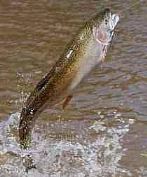
Steelhead migrate to the mouth of the river and change its pysiognomy to be able to process seawater. When conditions are right, the fish goes to sea for 2, 3 or 4 years, depending on its genetic disposition.In its ocean travels, the steelhead usually swims all the way to Australia, then up the Pacific Rim and through the Aleutians and the Bering Strait.
Usually, steelhead return to the same river where they were born. It will find a mate and spawn

Also, a population of the incredible Pacific lamprey has suffered great losses. This wondrous creature is a prehistoric fish. It has no jaw, but has a powerful suction mouth, which it uses for many functions.
A poor swimmer, lamprey propel themselves up a river by latching onto a boulder with its suction mouth, then throwing itself upstream. At sea, lamprey fasten on to a salmon, or other type of fish, and suck blood from the host. Lamprey has a mysterious anticoagulant which prevents the host’s fluids from coagulating when flowing through the lamprey system. It is thought that the lamprey cleanses the host’s blood by this filtering process.
Before going to sea, Lamprey young incubate up to seven years in a pool made by their parents in the river.
The parents make the nesting area together. Then they make the rearing pool for incubation. It is a sandy pool that the parents made by sucking rocks out of the area and depositing them away.
When the parents are done with the nest and incubating pool, they perform an elaborate mating ritual of twisting and twining around each other. Then, at the magical moment, the male fastens his mouth onto the female’s head. Then, together, she deposits her eggs, and the male fertilizes them in sync.
After four or five weeks, the eggs hatch, and the young migrate over to the rearing pool. There, the young suck up the diatoms and detritus in the sandy bottom and filter it through its system. This is a great asset to the river as the filtering cleanses.
Stewards of the Big Sur River
Beautiful Big Sur River is the quintessential California coastal waterway in the heart of our continent’s most robust natural habitats of biodiversity. It is one of the only two remaining untamed rivers running to the sea on this coast.
From its headwaters in the 5,000-foot-high granite peaks of the Ventana Wilderness, Big Sur River drains a magnificent watershed full of great conifer and pine forests. Its picturesque tributaries tumble into the River and through a long, lovely alluvial valley which is home to vast flora and wildlife habitats.
Winding through grand groves of ancient redwoods, the Big Sur River should be a great testimonial to the natural riches of coastal California. But it is a troubled river.
It is being loved to death by an army of humans.
Off shore is the deepest submarine canyon on earth. Mammoth displays of seabirds, marine mammals and fish occur close to the shore. Sea otters, birds and seals once thought to be extinct, thrive in near pristine, prehistoric conditions. Condors eat whales on the beach.
But in the Big Sur River humans are systematically destroying this precious river. Celebrated by famous poets as a place Not Man Apart, humans are unknowingly obliterating the delicate, wondrous work of Nature.
Visitors are using the River as a playground, bombarding the native fish spawning and rearing habitats by throwing and moving rocks, channeling and damming the river for human amusement. They do it because they don’t know better.
As a consequence of this rampant, misguided human behavior, the native fish population is less than one-fifth of what it was just fifteen years ago. There are other conditions, such as global climate warming, that contribute to the diminishment of our native fish. Our efforts, however, principally shall be aimed at conditions we must immediately improve.
This fact is particularly sad in light of the heroic journey of the sea-going steelhead.
Such a heroic life should not meet such an ignominious end because a beautiful river that would otherwise be such a wonderful natural habitat is so misused.
The paradox is that when people learn about the precious habitats of the Big Sur River, they warmly embrace a new attitude. They think of the greater good by not abusing the river for their own amusement.
What we will do
Beginning in the Spring, we will develop a community
campaign in three phases:
Respect
Develop education programs for schools, businesses,
coastal and valley residents and visitors about the River,
and why it is important to treat it respectfully. We will
initiate efforts to provide interpretive information about
native habitats in the Big Sur River Watershed.
Restoration
Develop and lead projects to remedy steelhead spawning
and rearing sites; repair crossings; rehabilitate streamside
native plant habitats; improve water quality.
Stewardship
Develop and lead programs, such as docents, that walk
the River areas and teach why it is important to not be
destructive to native habitats.
In this phase, we will initiate community discussions about art and natural history interpretation projects, and a river community trail.
j.e. feb 8, 08
Big Sur River information and observations
“There was a rendezvous here, where seventy-two miles of wild coast country lay dazzling in the sun. Rachel Carson called such meeting ‘a place of compromise, conflict and eternal change.’ Here sea and land consorted, the seeping moisture in each fold of the mountain range emerged and slipped musically into the shifting continents of kelp. The conflict and change was a natural interplay in the balance of life. Then came the road.” Margaret Owings, 1965:
“Along the central California coast, between Monterey and San Luis Obispo, a geologically young and still uplifting range of mountains rises abruptly from the Pacific Ocean, forming a backdrop to the dramatic Big Sur coast: the Santa Lucia Mountains. Unlike so much of the landscape of California, which has been greatly altered by human activities, the extremely rugged and inaccessible terrain of much of the Santa Lucia Mountains has sheltered this region from exploitation. With the possible exception of parts of the King Range south of Cape Mendocino, the Santa Lucia Mountains are probably the most pristine of all the Outer Coast Ranges. The flora has thus remained overwhelmingly native, and, due to a number of geoclimatic factors which combine in these mountains, a rich and highly diversified assortment of plants can be found in relatively close proximity with the borders of this range.”
David Rogers, Fremontia, Vol 19, No. 4
Stewards of the Big Sur River wants your help. We would like you to join our team. We will add you to our email network and keep you posted on the group’s efforts and progress.You can make a contribution, too. You can come to our meetings, and volunteer to be a docent.
|
|
